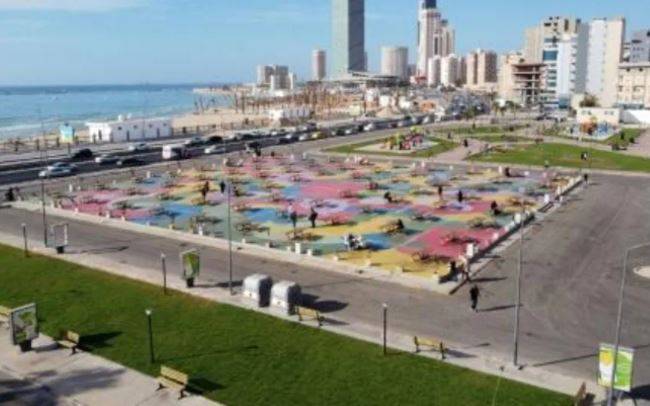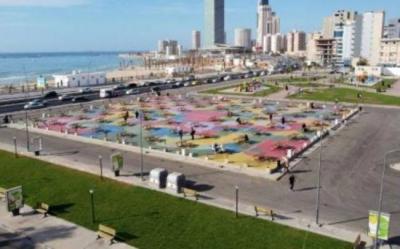Ten years ago, Libyans could not have imagined that one of the famous barracks established during Colonel Muammar Gaddafi's rule in central Tripoli would turn into a recreational complex. This is precisely what has happened to the "Military College for Girls," a symbol of a regime that took pride in having women guard its leader.
Following the February 2011 revolution that overthrew Gaddafi and led to his death, various armed groups vied for control of the site that graduated numerous female military personnel. The college saw repeated armed clashes until a governmental decision was issued four years ago to convert it into a recreational area. This decision marked a step toward clearing the capital of military sites amid residential neighborhoods.
Over the past years, repeated decisions have been made to rid cities of armed manifestations and military camps. Only the “Military College for Girls,” spanning 80,000 square meters, managed to see its transformation implemented. Since it opened to the public a few days ago, the complex located opposite the corniche on one of the Mediterranean beaches has not ceased to attract visitors.
The opening of the complex comes months after the formation of a new government in Libya tasked with overseeing a transitional phase that is expected to culminate in December with elections. Since its inauguration, Mohand Kachar has made it a point to attend the venue every evening with his three children and wife, where there is a cycling track and walking path, in addition to cafes and children's playgrounds amidst green grassy spaces.
Kachar tells AFP, "I am 47 years old and I love sports. For about two weeks now, I have consistently been coming here. I walk with my wife while my children play for long hours, returning home exhausted and just wanting to sleep." While laughing, his wife adds that the presence of the complex by the sea "makes it an exceptional environmental breathing space.” She further states, "You can feel the refreshing sea breeze. With so many families present every evening, you feel that Tripoli is alive, despite the ravages of the wars we have endured, and that the future, despite the challenges, is still bright."
Cycling enthusiasts now have a rare equipped track in Tripoli where they can practice their favorite sport. Mahmoud Tijani tells AFP, "We arrived yesterday from the city of Zawiya (45 km west of Tripoli) with five friends on our bikes, and we are enjoying the beautiful track that we lack in public parks." He adds, "It is also an opportunity to make new friendships and get to know fellow cyclists from different cities."
Tripoli's mayor, Ibrahim Khalifi, believes that converting one of Gaddafi's sites into a recreational complex was a "wise decision," noting that it received support from all parties within Tripoli. Khalifi explains from within the complex to AFP, "As the capital and with its large population, Tripoli needs such recreational spaces. There was an understanding from everyone and support for the government in turning this project into reality."
He continues, "What has happened is a qualitative leap, and the goal was to limit the phenomenon of weapons and their proliferation, and remove all military camps from urban areas, which is a prudent decision that allows Libyans to enjoy the prosperity and stability they deserve." The local official notes that the “recreational complex” is the first of several upcoming projects, including parks and coastal resorts that will be inaugurated soon. He adds, "Libyans need such green and sports spaces as they relieve the daily pressures and provide families with an opportunity to relax and entertain amidst the country’s well-known conditions." He mentions that thousands visit the complex daily.
### Art and Peace
Libyan visual artist Iskander Soukni sought to add an artistic touch within the complex by creating an installation on its floor carrying a message of peace. Soukni states that his initiative, supported by the Tripoli Municipality, aims to promote "peace and coexistence among Libyans." He adds that he tried "to create joy through colors, as art is a powerful message of peace that always triumphs over conflicts and helps in opening a new page of coexistence among the Libyan people."
The well-known artist executed his painting over an area of 2,500 square meters, taking approximately three months to complete it, using a mix of yellow, red, and blue colors in the form of meticulous circles and waves resembling those of the sea, which, according to Soukni, symbolize the triumph of the will to live over destruction.
The cleanliness of the place is striking, with trash bins placed in every corner. Some families sit around cups of tea or coffee on wooden tables and benches, while some children rush after an ice cream truck that has entered the park. Soukni expresses hope that "this experience will be replicated in most Libyan cities," as art and entertainment represent "a message of peace that Libya is in dire need of."




